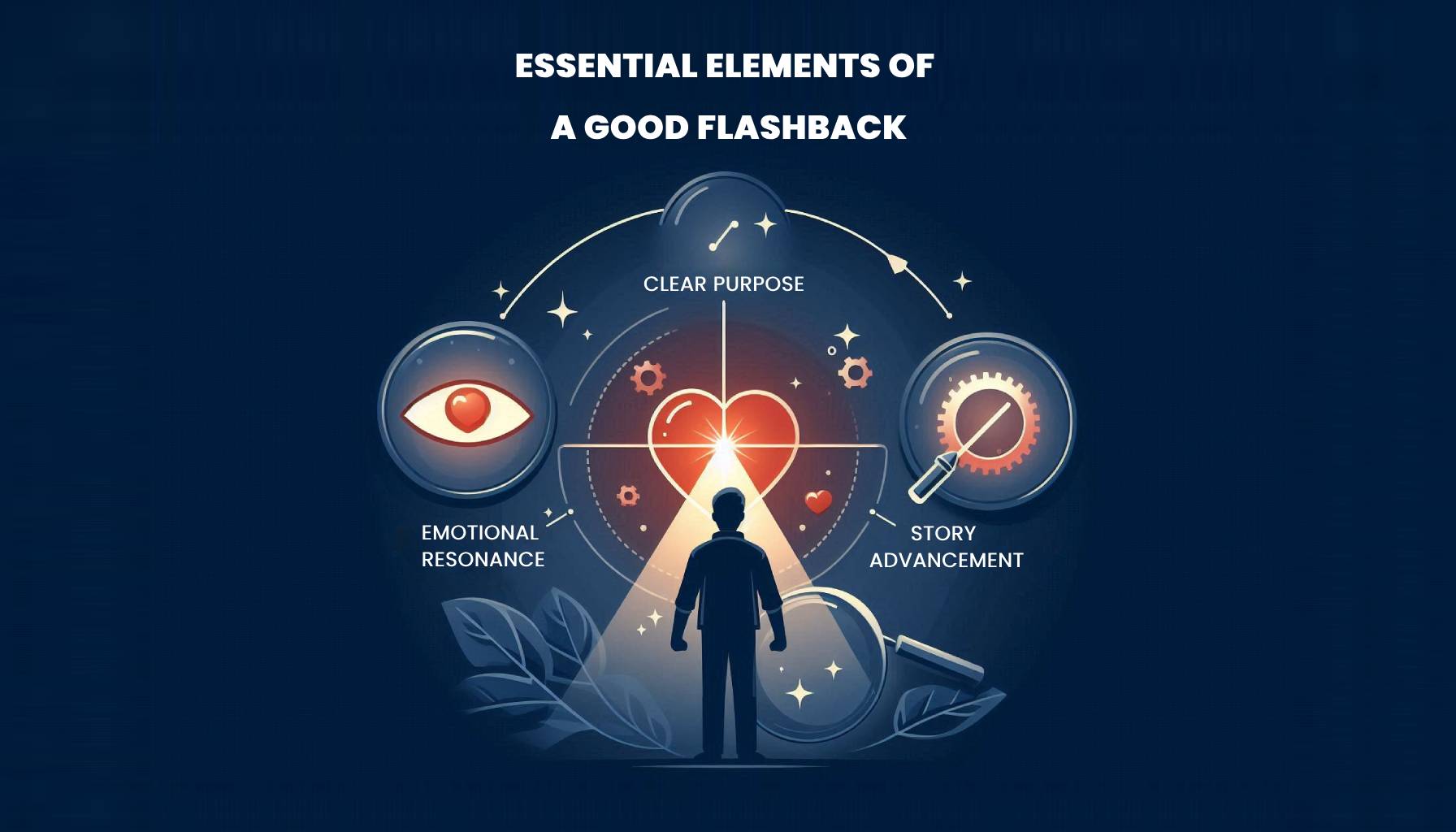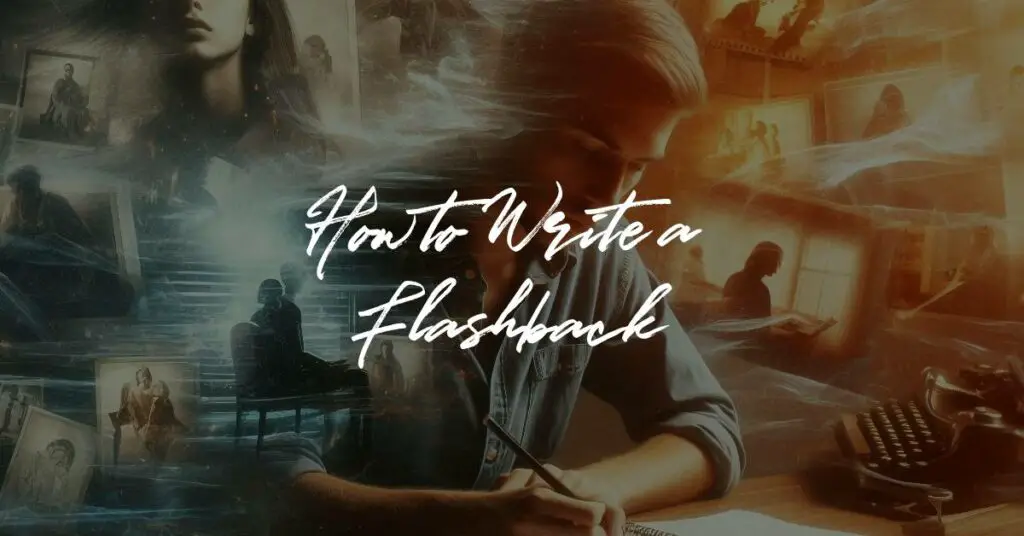Picture this: Darth Vader’s iconic revelation to Luke Skywalker in “The Empire Strikes Back.” While not technically a flashback, this moment demonstrates how past revelations can shake a character’s world – and the audience’s – to its core.
This is the power of effectively revealing the past in your script, and mastering flashbacks is key to wielding this power in your storytelling arsenal.
Understanding Flashbacks: More Than Just Looking Back
A flashback is a narrative device that interrupts the current timeline of a script to show events that occurred in the past.
But it’s much more than simply jumping back in time – it’s a sophisticated tool that, when used properly, can deepen character development, reveal crucial plot points, and create powerful emotional resonance with your audience.
Types of Flashbacks in Screenwriting
Screenwriters have several types of flashbacks at their disposal:
- Memory Hits/Quick Flashes: Brief glimpses lasting only a few seconds, often used to show traumatic memories or sudden realizations. Think of the quick flashes in “The Bourne Identity” as Jason Bourne slowly pieces together his past.
- Flashback Sequences: A series of connected moments from the past that tell a complete mini-story. “The Godfather Part II” masterfully uses these to tell Vito Corleone’s origin story.
- Full Scene Flashbacks: Complete scenes that play out in the past, often used to reveal crucial plot points or character backstory. “Citizen Kane” practically wrote the book on this technique.
- Montage Flashbacks: A collection of past moments edited together to show a passage of time or theme. “Up” uses this beautifully in its heart-wrenching opening sequence.
The Psychology Behind Effective Flashbacks
Great flashbacks don’t just show the past – they excavate emotional truth. They work because they tap into universal human experiences:
Emotional Triggers That Make Flashbacks Work
Past Trauma: When characters confront painful memories, audiences connect with their own experiences of processing difficult events.
Startling Revelations: A well-timed flashback can recontextualize everything the audience thought they knew, creating powerful “aha” moments.
Nostalgia: Flashbacks can evoke bittersweet emotions by showing happier times, making present struggles more poignant.
Essential Elements of a Good Flashback
For a flashback to enhance rather than derail your script, it must contain these crucial elements:
- Clear Purpose: Every flashback needs to earn its place by revealing something vital to the story that can’t be effectively shown any other way.
- Emotional Resonance: The flashback should connect emotionally with both the character and the audience.
- Story Advancement: Rather than merely providing background information, good flashbacks move the present story forward.
- Visual Distinctiveness: The past should be visually distinguishable from the present through clear formatting and descriptive writing.

Technical Formatting Guide
Proper formatting ensures your flashback reads clearly on the page. Here’s how to handle different types:
Single Scene Flashback
INT. BEDROOM - NIGHT (PRESENT DAY)
Sarah touches the old photograph, her hands trembling.
FLASHBACK - INT. BEDROOM - NIGHT (1985)
Young Sarah watches as her father packs a suitcase, tears streaming down his face.
BACK TO PRESENT
Quick Flash
INT. COURTHOUSE - DAY
John approaches the witness stand --
QUICK FLASH - INT. ALLEY - NIGHT
A gun fires. A body falls.
BACK TO SCENE
Multiple Scene Sequence
BEGIN FLASHBACK SEQUENCE
INT. HOSPITAL - NIGHT (1999)
[Scene description]
INT. DOCTOR'S OFFICE - DAY (1999)
[Scene description]
END FLASHBACK SEQUENCE
Common Mistakes to Avoid
Don’t let your script fall prey to these common flashback pitfalls:
- Overuse: When everything is a flashback, nothing is. Use them sparingly for maximum impact.
- Poor Transitions: Abrupt or unclear transitions can confuse and frustrate readers.
- Unnecessary Exposition: If the information could be revealed through dialogue or action in the present, a flashback might not be needed.
- Disrupting Flow: Flashbacks should enhance the narrative rhythm, not break it.
Best Practices for Writing Flashbacks
Follow these guidelines to craft effective flashbacks:
- Choose Strategic Moments: Place flashbacks at points where they’ll have the maximum emotional impact.
- Create Smooth Transitions: Use visual or auditory bridges between present and past. A song, an object, or a similar action can connect the two timelines seamlessly.
- Maintain Momentum: Keep the energy of your story moving forward, even when looking back.
- Connect to Character: Every flashback should reveal something meaningful about your character’s present situation or motivation.
Case Studies: Successful Flashbacks in Famous Scripts
Let’s examine some masterful uses of flashbacks:
- Uses unreliable narrator and fractured memories to hide its twist
- Flashbacks serve dual purposes, seeming to reveal one thing while actually setting up a bigger revelation
- Technical execution involves quick cuts and disorienting transitions that mirror the protagonist’s mental state
“Eternal Sunshine of the Spotless Mind” (2004):
- Entire narrative structure built around memories being erased
- Flashbacks become increasingly distorted as memories fade
- Uses visual effects and set design to show memory deterioration
Advanced Techniques
For writers ready to push boundaries:
- Non-linear Storytelling: Use flashbacks as part of a larger non-linear structure, like “Memento” or “Pulp Fiction.”
- Multiple Timeline Management: Weave together several time periods, ensuring each adds unique value to the story.
- Visual and Audio Cues: Develop consistent markers that help audiences track time shifts:
- Color grading differences between time periods
- Specific music for memory sequences
- Recurring visual motifs
Essential Checklist for Writing Flashbacks
Before finalizing your flashback scenes, verify:
✓ Purpose: Does this flashback reveal crucial information?
✓ Timing: Is this the most effective moment for this revelation?
✓ Format: Is the technical formatting clear and consistent?
✓ Impact: Does it create an emotional response?
✓ Flow: Does it maintain story momentum?
✓ Clarity: Will the audience easily follow the time shift?
Tools and Resources
Recommended Screenwriting Software
- Final Draft
- WriterDuet
- Fade In
- Celtx
Professional Script Examples
Study produced scripts that effectively use flashbacks:
- “Inception” by Christopher Nolan
- “Slumdog Millionaire” by Simon Beaufoy
- “The Usual Suspects” by Christopher McQuarrie
The Art of Looking Back to Move Forward
Flashbacks, when executed skillfully, are more than just a glimpse into the past – they’re a powerful tool for deepening your story and engaging your audience.
Remember that every look back should push your story forward, reveal character, and create emotional resonance.
As you craft your own flashbacks, keep these final thoughts in mind:
- Make every flashback necessary and meaningful
- Maintain clear formatting and smooth transitions
- Use them to enhance, not replace, present-day storytelling
- Trust your audience to follow well-crafted time shifts
Frequently Asked Questions
Q: How many flashbacks is too many?
A: While there’s no strict rule, each flashback should serve a unique and necessary purpose. If you have more than 3-4 major flashbacks in a feature script, carefully evaluate whether each one is essential.
Q: Should flashbacks be written in past tense?
A: No, write flashbacks in present tense, just like the rest of your script. The formatting and scene headings will indicate that it’s a past event.
Q: Can flashbacks open a script?
A: Yes, but ensure it serves a strong purpose. Opening with a flashback can be effective for establishing backstory or creating mystery, but it shouldn’t delay getting into your main story.
Q: How do you handle time periods in flashback formatting?
A: Include the year or time period in parentheses in the scene heading: INT. HOUSE – DAY (1985)
Remember, mastering flashbacks takes practice and careful consideration. Keep studying successful examples, and don’t be afraid to experiment with different techniques while staying true to your story’s needs. Your goal is to create flashbacks that feel not just logical, but inevitable – moments that make your audience think, “Of course, now everything makes sense.”
